Detailed Analysis of Presentations, Mail Handling Procedures
VerifiedAdded on 2020/06/05
|18
|5615
|35
Homework Assignment
AI Summary
This assignment provides a detailed exploration of business communication, focusing on two key areas: presentation skills and mail handling procedures. It begins by analyzing various presentation methods, media, and the impact of audience size on delivery, including contingency planning, voice projection, and question-and-answer techniques. The assignment then delves into mail handling, covering topics such as dealing with junk mail, handling problems with incoming and outgoing mail, operating a franking machine, preparing packages, and adhering to organizational policies on mail security and courier services. Further, it includes procedures for reporting suspicious items, and determining the best dispatch options. The assignment also addresses information storage and retrieval systems, legal and organizational requirements for information security, filing systems, search techniques, and problem-solving. Additionally, it touches upon maintaining stationery and supplies, resolving customer complaints, and using word processing software. Overall, this assignment provides a comprehensive overview of essential business communication and operational procedures.

Paraphrase This Document
Need a fresh take? Get an instant paraphrase of this document with our AI Paraphraser

Table of Contents
INTRODUCTION ..........................................................................................................................1
Task 1...............................................................................................................................................1
1.1 Analyse the advantages and limitations of different methods of, and media for, making
presentations................................................................................................................................1
1.2 Explain how the type and size of the audience affects the delivery of a presentation..........1
1.3 Explain the factors to be taken into account in developing contingency plans when
delivering presentations..............................................................................................................1
Probability...................................................................................................................................1
Impact..........................................................................................................................................2
1.4 Explain voice projection and timing techniques when delivering presentations..................2
1. Fear of public speaking and presentations.....................................................................2
2. Understanding/overcoming fear of public speaking and presentations.........................2
1.5 Explain the factors to be taken into account in responding to questions from an audience..2
Step One - Listen....................................................................................................................2
Step Two - Understand...........................................................................................................2
1.6 Explain different methods for evaluating the effectiveness of a presentation......................3
Check goal set.............................................................................................................................3
Measure accomplishments..........................................................................................................3
Pupil self evaluation....................................................................................................................3
Task 2...............................................................................................................................................3
1.1 Explain how to deal with “junk” mail...................................................................................3
1.2 Describe what to do in the event of problems arising when dealing with incoming or
outgoing mail..............................................................................................................................3
1.3 Describe how to operate a franking machine .......................................................................4
1.4 Explain how to prepare packages for distribution.................................................................4
1.5 State organisational policies and procedures on mail handling, security and the use of
courier services ...........................................................................................................................4
1.6 Explain the process for reporting suspicious or damaged items in accordance with
organisational procedures............................................................................................................4
INTRODUCTION ..........................................................................................................................1
Task 1...............................................................................................................................................1
1.1 Analyse the advantages and limitations of different methods of, and media for, making
presentations................................................................................................................................1
1.2 Explain how the type and size of the audience affects the delivery of a presentation..........1
1.3 Explain the factors to be taken into account in developing contingency plans when
delivering presentations..............................................................................................................1
Probability...................................................................................................................................1
Impact..........................................................................................................................................2
1.4 Explain voice projection and timing techniques when delivering presentations..................2
1. Fear of public speaking and presentations.....................................................................2
2. Understanding/overcoming fear of public speaking and presentations.........................2
1.5 Explain the factors to be taken into account in responding to questions from an audience..2
Step One - Listen....................................................................................................................2
Step Two - Understand...........................................................................................................2
1.6 Explain different methods for evaluating the effectiveness of a presentation......................3
Check goal set.............................................................................................................................3
Measure accomplishments..........................................................................................................3
Pupil self evaluation....................................................................................................................3
Task 2...............................................................................................................................................3
1.1 Explain how to deal with “junk” mail...................................................................................3
1.2 Describe what to do in the event of problems arising when dealing with incoming or
outgoing mail..............................................................................................................................3
1.3 Describe how to operate a franking machine .......................................................................4
1.4 Explain how to prepare packages for distribution.................................................................4
1.5 State organisational policies and procedures on mail handling, security and the use of
courier services ...........................................................................................................................4
1.6 Explain the process for reporting suspicious or damaged items in accordance with
organisational procedures............................................................................................................4
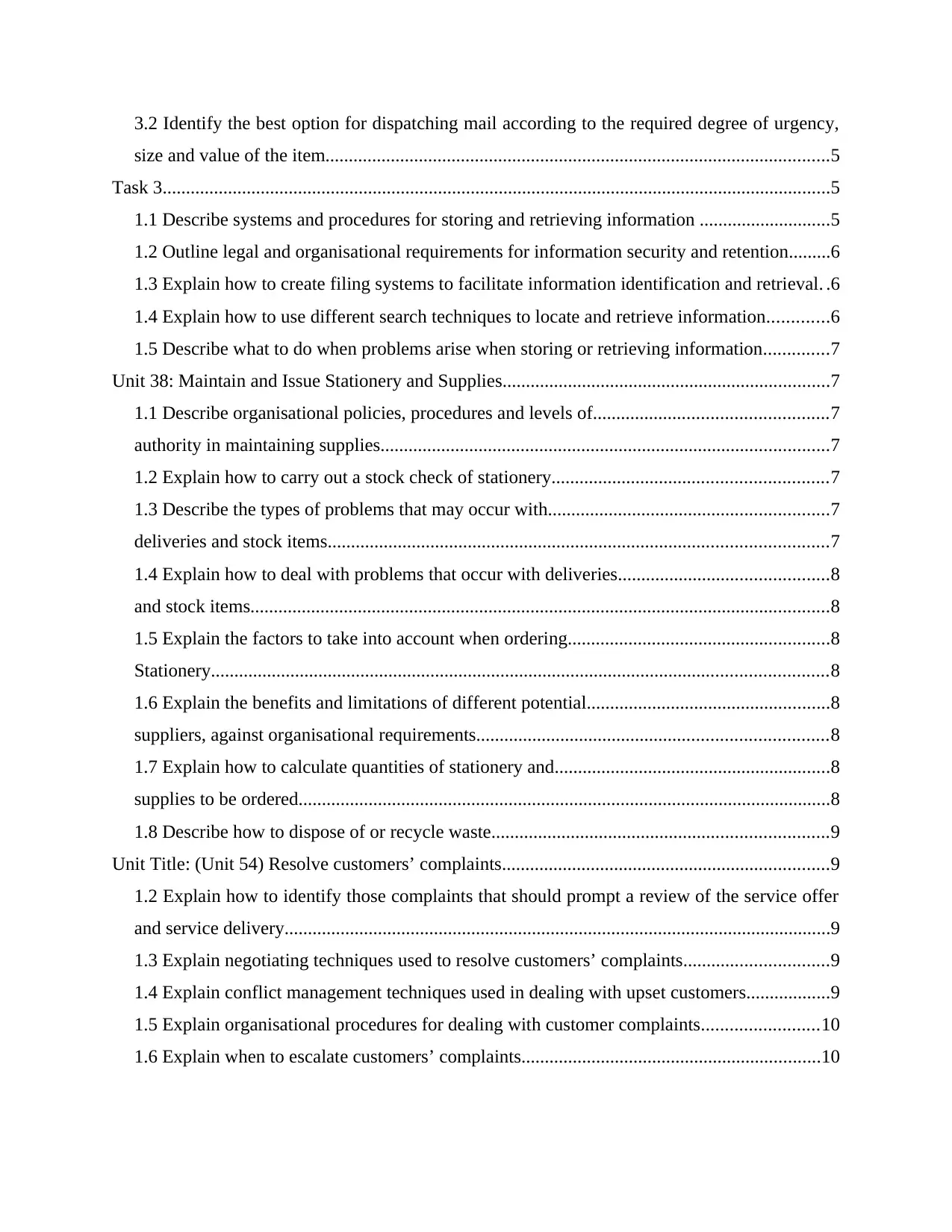
3.2 Identify the best option for dispatching mail according to the required degree of urgency,
size and value of the item............................................................................................................5
Task 3...............................................................................................................................................5
1.1 Describe systems and procedures for storing and retrieving information ............................5
1.2 Outline legal and organisational requirements for information security and retention.........6
1.3 Explain how to create filing systems to facilitate information identification and retrieval. .6
1.4 Explain how to use different search techniques to locate and retrieve information.............6
1.5 Describe what to do when problems arise when storing or retrieving information..............7
Unit 38: Maintain and Issue Stationery and Supplies......................................................................7
1.1 Describe organisational policies, procedures and levels of..................................................7
authority in maintaining supplies................................................................................................7
1.2 Explain how to carry out a stock check of stationery...........................................................7
1.3 Describe the types of problems that may occur with............................................................7
deliveries and stock items...........................................................................................................7
1.4 Explain how to deal with problems that occur with deliveries.............................................8
and stock items............................................................................................................................8
1.5 Explain the factors to take into account when ordering........................................................8
Stationery....................................................................................................................................8
1.6 Explain the benefits and limitations of different potential....................................................8
suppliers, against organisational requirements...........................................................................8
1.7 Explain how to calculate quantities of stationery and...........................................................8
supplies to be ordered..................................................................................................................8
1.8 Describe how to dispose of or recycle waste........................................................................9
Unit Title: (Unit 54) Resolve customers’ complaints......................................................................9
1.2 Explain how to identify those complaints that should prompt a review of the service offer
and service delivery.....................................................................................................................9
1.3 Explain negotiating techniques used to resolve customers’ complaints...............................9
1.4 Explain conflict management techniques used in dealing with upset customers..................9
1.5 Explain organisational procedures for dealing with customer complaints.........................10
1.6 Explain when to escalate customers’ complaints................................................................10
size and value of the item............................................................................................................5
Task 3...............................................................................................................................................5
1.1 Describe systems and procedures for storing and retrieving information ............................5
1.2 Outline legal and organisational requirements for information security and retention.........6
1.3 Explain how to create filing systems to facilitate information identification and retrieval. .6
1.4 Explain how to use different search techniques to locate and retrieve information.............6
1.5 Describe what to do when problems arise when storing or retrieving information..............7
Unit 38: Maintain and Issue Stationery and Supplies......................................................................7
1.1 Describe organisational policies, procedures and levels of..................................................7
authority in maintaining supplies................................................................................................7
1.2 Explain how to carry out a stock check of stationery...........................................................7
1.3 Describe the types of problems that may occur with............................................................7
deliveries and stock items...........................................................................................................7
1.4 Explain how to deal with problems that occur with deliveries.............................................8
and stock items............................................................................................................................8
1.5 Explain the factors to take into account when ordering........................................................8
Stationery....................................................................................................................................8
1.6 Explain the benefits and limitations of different potential....................................................8
suppliers, against organisational requirements...........................................................................8
1.7 Explain how to calculate quantities of stationery and...........................................................8
supplies to be ordered..................................................................................................................8
1.8 Describe how to dispose of or recycle waste........................................................................9
Unit Title: (Unit 54) Resolve customers’ complaints......................................................................9
1.2 Explain how to identify those complaints that should prompt a review of the service offer
and service delivery.....................................................................................................................9
1.3 Explain negotiating techniques used to resolve customers’ complaints...............................9
1.4 Explain conflict management techniques used in dealing with upset customers..................9
1.5 Explain organisational procedures for dealing with customer complaints.........................10
1.6 Explain when to escalate customers’ complaints................................................................10
⊘ This is a preview!⊘
Do you want full access?
Subscribe today to unlock all pages.

Trusted by 1+ million students worldwide
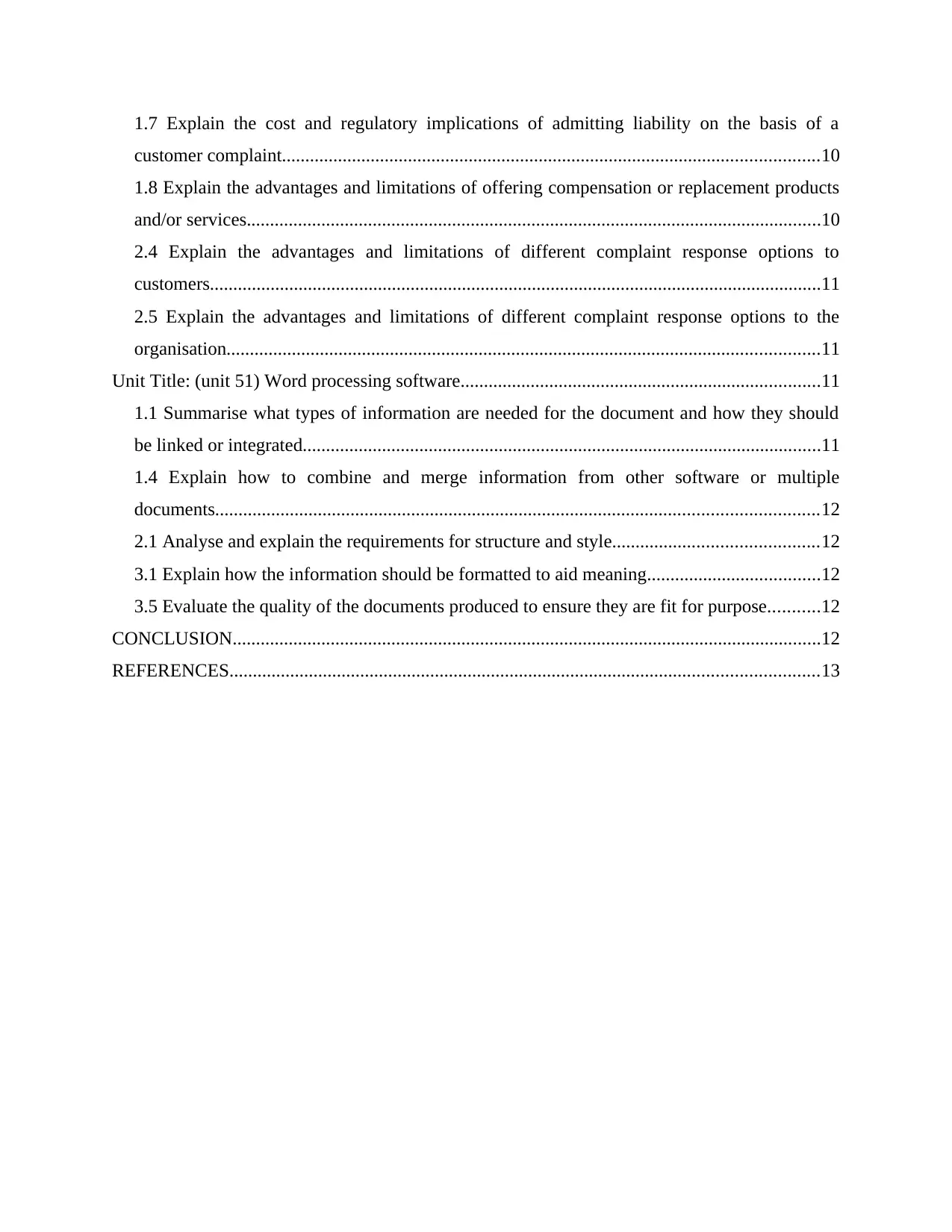
1.7 Explain the cost and regulatory implications of admitting liability on the basis of a
customer complaint...................................................................................................................10
1.8 Explain the advantages and limitations of offering compensation or replacement products
and/or services...........................................................................................................................10
2.4 Explain the advantages and limitations of different complaint response options to
customers...................................................................................................................................11
2.5 Explain the advantages and limitations of different complaint response options to the
organisation...............................................................................................................................11
Unit Title: (unit 51) Word processing software.............................................................................11
1.1 Summarise what types of information are needed for the document and how they should
be linked or integrated...............................................................................................................11
1.4 Explain how to combine and merge information from other software or multiple
documents.................................................................................................................................12
2.1 Analyse and explain the requirements for structure and style............................................12
3.1 Explain how the information should be formatted to aid meaning.....................................12
3.5 Evaluate the quality of the documents produced to ensure they are fit for purpose...........12
CONCLUSION..............................................................................................................................12
REFERENCES..............................................................................................................................13
customer complaint...................................................................................................................10
1.8 Explain the advantages and limitations of offering compensation or replacement products
and/or services...........................................................................................................................10
2.4 Explain the advantages and limitations of different complaint response options to
customers...................................................................................................................................11
2.5 Explain the advantages and limitations of different complaint response options to the
organisation...............................................................................................................................11
Unit Title: (unit 51) Word processing software.............................................................................11
1.1 Summarise what types of information are needed for the document and how they should
be linked or integrated...............................................................................................................11
1.4 Explain how to combine and merge information from other software or multiple
documents.................................................................................................................................12
2.1 Analyse and explain the requirements for structure and style............................................12
3.1 Explain how the information should be formatted to aid meaning.....................................12
3.5 Evaluate the quality of the documents produced to ensure they are fit for purpose...........12
CONCLUSION..............................................................................................................................12
REFERENCES..............................................................................................................................13
Paraphrase This Document
Need a fresh take? Get an instant paraphrase of this document with our AI Paraphraser
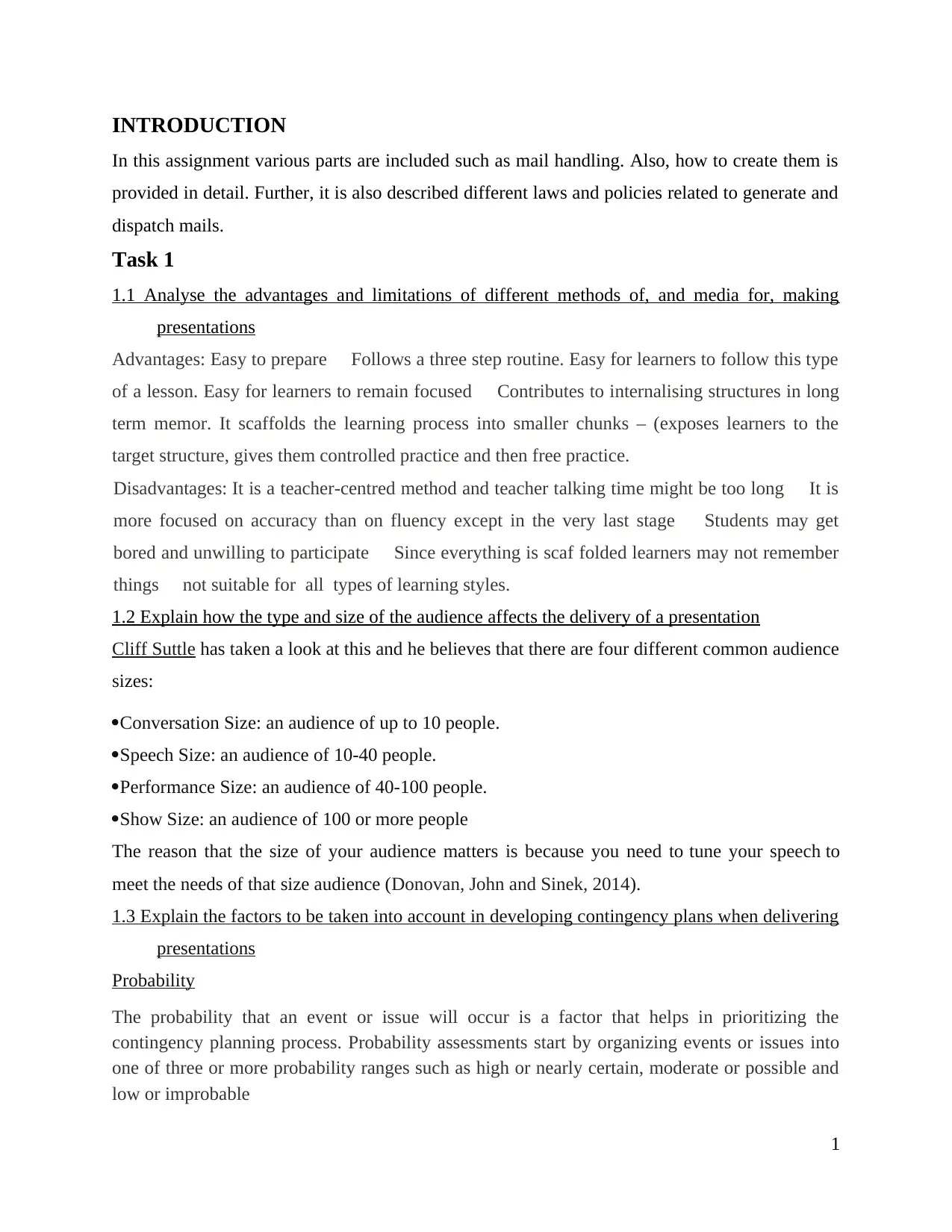
INTRODUCTION
In this assignment various parts are included such as mail handling. Also, how to create them is
provided in detail. Further, it is also described different laws and policies related to generate and
dispatch mails.
Task 1
1.1 Analyse the advantages and limitations of different methods of, and media for, making
presentations
Advantages: Easy to prepare Follows a three step routine. Easy for learners to follow this type
of a lesson. Easy for learners to remain focused Contributes to internalising structures in long
term memor. It scaffolds the learning process into smaller chunks – (exposes learners to the
target structure, gives them controlled practice and then free practice.
Disadvantages: It is a teacher-centred method and teacher talking time might be too long It is
more focused on accuracy than on fluency except in the very last stage Students may get
bored and unwilling to participate Since everything is scaf folded learners may not remember
things not suitable for all types of learning styles.
1.2 Explain how the type and size of the audience affects the delivery of a presentation
Cliff Suttle has taken a look at this and he believes that there are four different common audience
sizes:
Conversation Size: an audience of up to 10 people.
Speech Size: an audience of 10-40 people.
Performance Size: an audience of 40-100 people.
Show Size: an audience of 100 or more people
The reason that the size of your audience matters is because you need to tune your speech to
meet the needs of that size audience (Donovan, John and Sinek, 2014).
1.3 Explain the factors to be taken into account in developing contingency plans when delivering
presentations
Probability
The probability that an event or issue will occur is a factor that helps in prioritizing the
contingency planning process. Probability assessments start by organizing events or issues into
one of three or more probability ranges such as high or nearly certain, moderate or possible and
low or improbable
1
In this assignment various parts are included such as mail handling. Also, how to create them is
provided in detail. Further, it is also described different laws and policies related to generate and
dispatch mails.
Task 1
1.1 Analyse the advantages and limitations of different methods of, and media for, making
presentations
Advantages: Easy to prepare Follows a three step routine. Easy for learners to follow this type
of a lesson. Easy for learners to remain focused Contributes to internalising structures in long
term memor. It scaffolds the learning process into smaller chunks – (exposes learners to the
target structure, gives them controlled practice and then free practice.
Disadvantages: It is a teacher-centred method and teacher talking time might be too long It is
more focused on accuracy than on fluency except in the very last stage Students may get
bored and unwilling to participate Since everything is scaf folded learners may not remember
things not suitable for all types of learning styles.
1.2 Explain how the type and size of the audience affects the delivery of a presentation
Cliff Suttle has taken a look at this and he believes that there are four different common audience
sizes:
Conversation Size: an audience of up to 10 people.
Speech Size: an audience of 10-40 people.
Performance Size: an audience of 40-100 people.
Show Size: an audience of 100 or more people
The reason that the size of your audience matters is because you need to tune your speech to
meet the needs of that size audience (Donovan, John and Sinek, 2014).
1.3 Explain the factors to be taken into account in developing contingency plans when delivering
presentations
Probability
The probability that an event or issue will occur is a factor that helps in prioritizing the
contingency planning process. Probability assessments start by organizing events or issues into
one of three or more probability ranges such as high or nearly certain, moderate or possible and
low or improbable
1
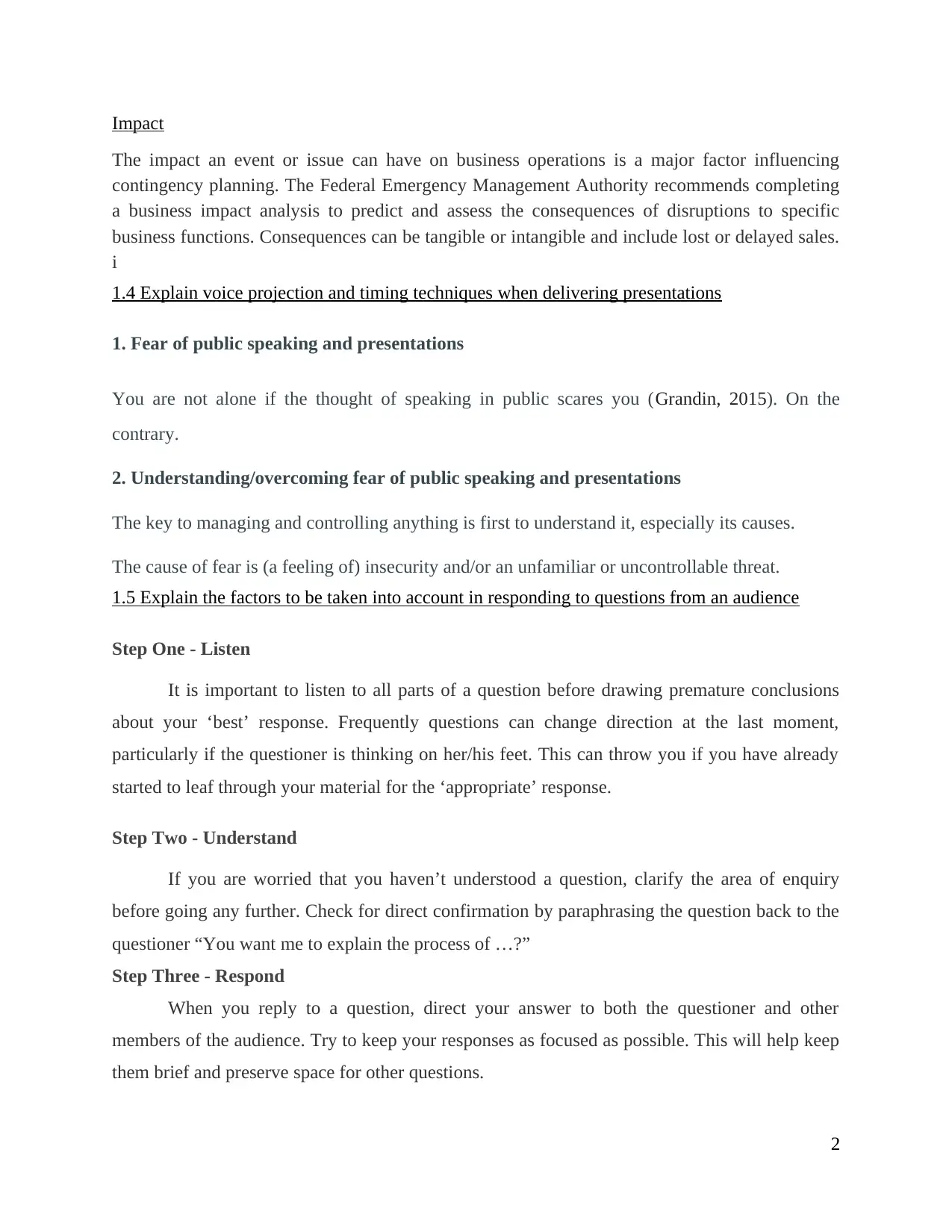
Impact
The impact an event or issue can have on business operations is a major factor influencing
contingency planning. The Federal Emergency Management Authority recommends completing
a business impact analysis to predict and assess the consequences of disruptions to specific
business functions. Consequences can be tangible or intangible and include lost or delayed sales.
i
1.4 Explain voice projection and timing techniques when delivering presentations
1. Fear of public speaking and presentations
You are not alone if the thought of speaking in public scares you (Grandin, 2015). On the
contrary.
2. Understanding/overcoming fear of public speaking and presentations
The key to managing and controlling anything is first to understand it, especially its causes.
The cause of fear is (a feeling of) insecurity and/or an unfamiliar or uncontrollable threat.
1.5 Explain the factors to be taken into account in responding to questions from an audience
Step One - Listen
It is important to listen to all parts of a question before drawing premature conclusions
about your ‘best’ response. Frequently questions can change direction at the last moment,
particularly if the questioner is thinking on her/his feet. This can throw you if you have already
started to leaf through your material for the ‘appropriate’ response.
Step Two - Understand
If you are worried that you haven’t understood a question, clarify the area of enquiry
before going any further. Check for direct confirmation by paraphrasing the question back to the
questioner “You want me to explain the process of …?”
Step Three - Respond
When you reply to a question, direct your answer to both the questioner and other
members of the audience. Try to keep your responses as focused as possible. This will help keep
them brief and preserve space for other questions.
2
The impact an event or issue can have on business operations is a major factor influencing
contingency planning. The Federal Emergency Management Authority recommends completing
a business impact analysis to predict and assess the consequences of disruptions to specific
business functions. Consequences can be tangible or intangible and include lost or delayed sales.
i
1.4 Explain voice projection and timing techniques when delivering presentations
1. Fear of public speaking and presentations
You are not alone if the thought of speaking in public scares you (Grandin, 2015). On the
contrary.
2. Understanding/overcoming fear of public speaking and presentations
The key to managing and controlling anything is first to understand it, especially its causes.
The cause of fear is (a feeling of) insecurity and/or an unfamiliar or uncontrollable threat.
1.5 Explain the factors to be taken into account in responding to questions from an audience
Step One - Listen
It is important to listen to all parts of a question before drawing premature conclusions
about your ‘best’ response. Frequently questions can change direction at the last moment,
particularly if the questioner is thinking on her/his feet. This can throw you if you have already
started to leaf through your material for the ‘appropriate’ response.
Step Two - Understand
If you are worried that you haven’t understood a question, clarify the area of enquiry
before going any further. Check for direct confirmation by paraphrasing the question back to the
questioner “You want me to explain the process of …?”
Step Three - Respond
When you reply to a question, direct your answer to both the questioner and other
members of the audience. Try to keep your responses as focused as possible. This will help keep
them brief and preserve space for other questions.
2
⊘ This is a preview!⊘
Do you want full access?
Subscribe today to unlock all pages.

Trusted by 1+ million students worldwide
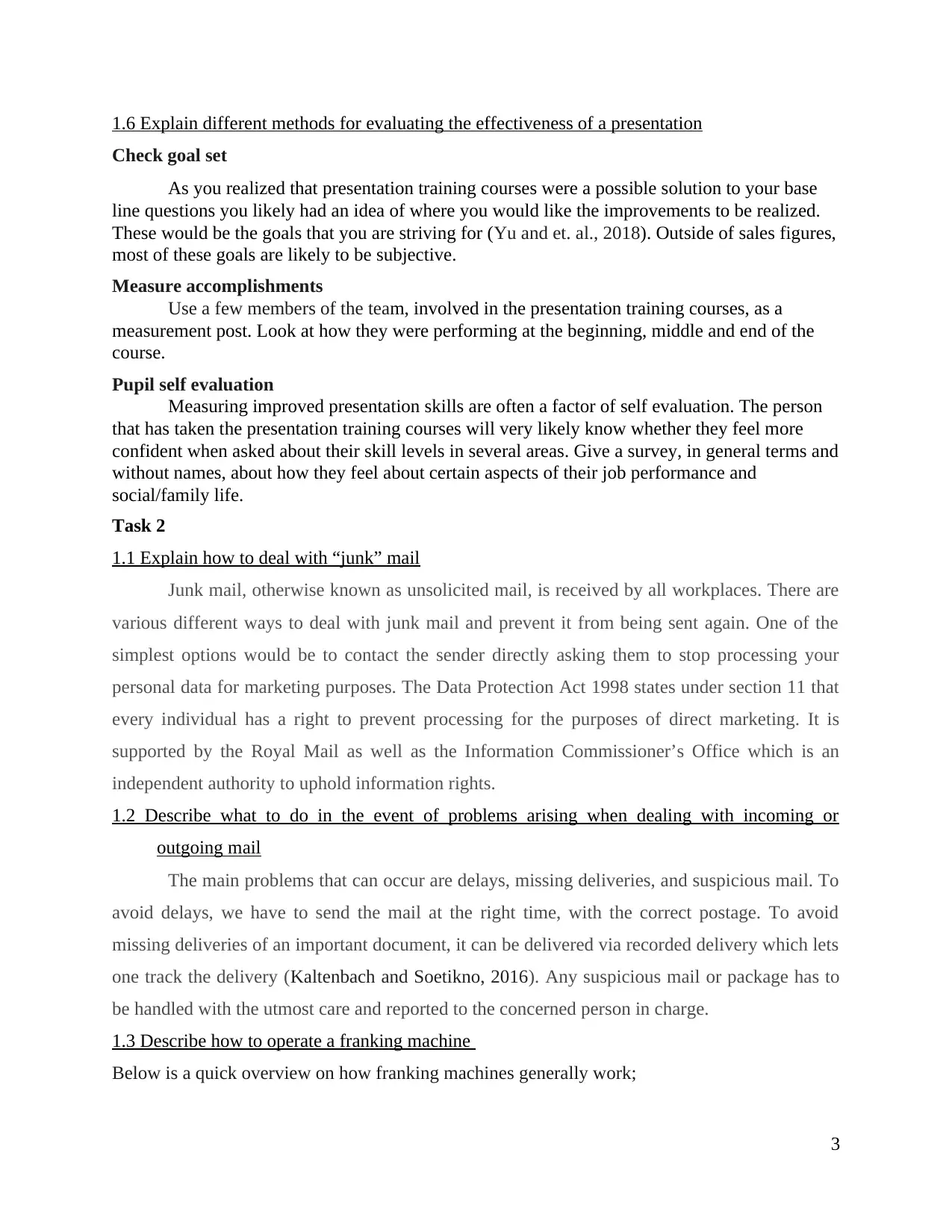
1.6 Explain different methods for evaluating the effectiveness of a presentation
Check goal set
As you realized that presentation training courses were a possible solution to your base
line questions you likely had an idea of where you would like the improvements to be realized.
These would be the goals that you are striving for (Yu and et. al., 2018). Outside of sales figures,
most of these goals are likely to be subjective.
Measure accomplishments
Use a few members of the team, involved in the presentation training courses, as a
measurement post. Look at how they were performing at the beginning, middle and end of the
course.
Pupil self evaluation
Measuring improved presentation skills are often a factor of self evaluation. The person
that has taken the presentation training courses will very likely know whether they feel more
confident when asked about their skill levels in several areas. Give a survey, in general terms and
without names, about how they feel about certain aspects of their job performance and
social/family life.
Task 2
1.1 Explain how to deal with “junk” mail
Junk mail, otherwise known as unsolicited mail, is received by all workplaces. There are
various different ways to deal with junk mail and prevent it from being sent again. One of the
simplest options would be to contact the sender directly asking them to stop processing your
personal data for marketing purposes. The Data Protection Act 1998 states under section 11 that
every individual has a right to prevent processing for the purposes of direct marketing. It is
supported by the Royal Mail as well as the Information Commissioner’s Office which is an
independent authority to uphold information rights.
1.2 Describe what to do in the event of problems arising when dealing with incoming or
outgoing mail
The main problems that can occur are delays, missing deliveries, and suspicious mail. To
avoid delays, we have to send the mail at the right time, with the correct postage. To avoid
missing deliveries of an important document, it can be delivered via recorded delivery which lets
one track the delivery (Kaltenbach and Soetikno, 2016). Any suspicious mail or package has to
be handled with the utmost care and reported to the concerned person in charge.
1.3 Describe how to operate a franking machine
Below is a quick overview on how franking machines generally work;
3
Check goal set
As you realized that presentation training courses were a possible solution to your base
line questions you likely had an idea of where you would like the improvements to be realized.
These would be the goals that you are striving for (Yu and et. al., 2018). Outside of sales figures,
most of these goals are likely to be subjective.
Measure accomplishments
Use a few members of the team, involved in the presentation training courses, as a
measurement post. Look at how they were performing at the beginning, middle and end of the
course.
Pupil self evaluation
Measuring improved presentation skills are often a factor of self evaluation. The person
that has taken the presentation training courses will very likely know whether they feel more
confident when asked about their skill levels in several areas. Give a survey, in general terms and
without names, about how they feel about certain aspects of their job performance and
social/family life.
Task 2
1.1 Explain how to deal with “junk” mail
Junk mail, otherwise known as unsolicited mail, is received by all workplaces. There are
various different ways to deal with junk mail and prevent it from being sent again. One of the
simplest options would be to contact the sender directly asking them to stop processing your
personal data for marketing purposes. The Data Protection Act 1998 states under section 11 that
every individual has a right to prevent processing for the purposes of direct marketing. It is
supported by the Royal Mail as well as the Information Commissioner’s Office which is an
independent authority to uphold information rights.
1.2 Describe what to do in the event of problems arising when dealing with incoming or
outgoing mail
The main problems that can occur are delays, missing deliveries, and suspicious mail. To
avoid delays, we have to send the mail at the right time, with the correct postage. To avoid
missing deliveries of an important document, it can be delivered via recorded delivery which lets
one track the delivery (Kaltenbach and Soetikno, 2016). Any suspicious mail or package has to
be handled with the utmost care and reported to the concerned person in charge.
1.3 Describe how to operate a franking machine
Below is a quick overview on how franking machines generally work;
3
Paraphrase This Document
Need a fresh take? Get an instant paraphrase of this document with our AI Paraphraser
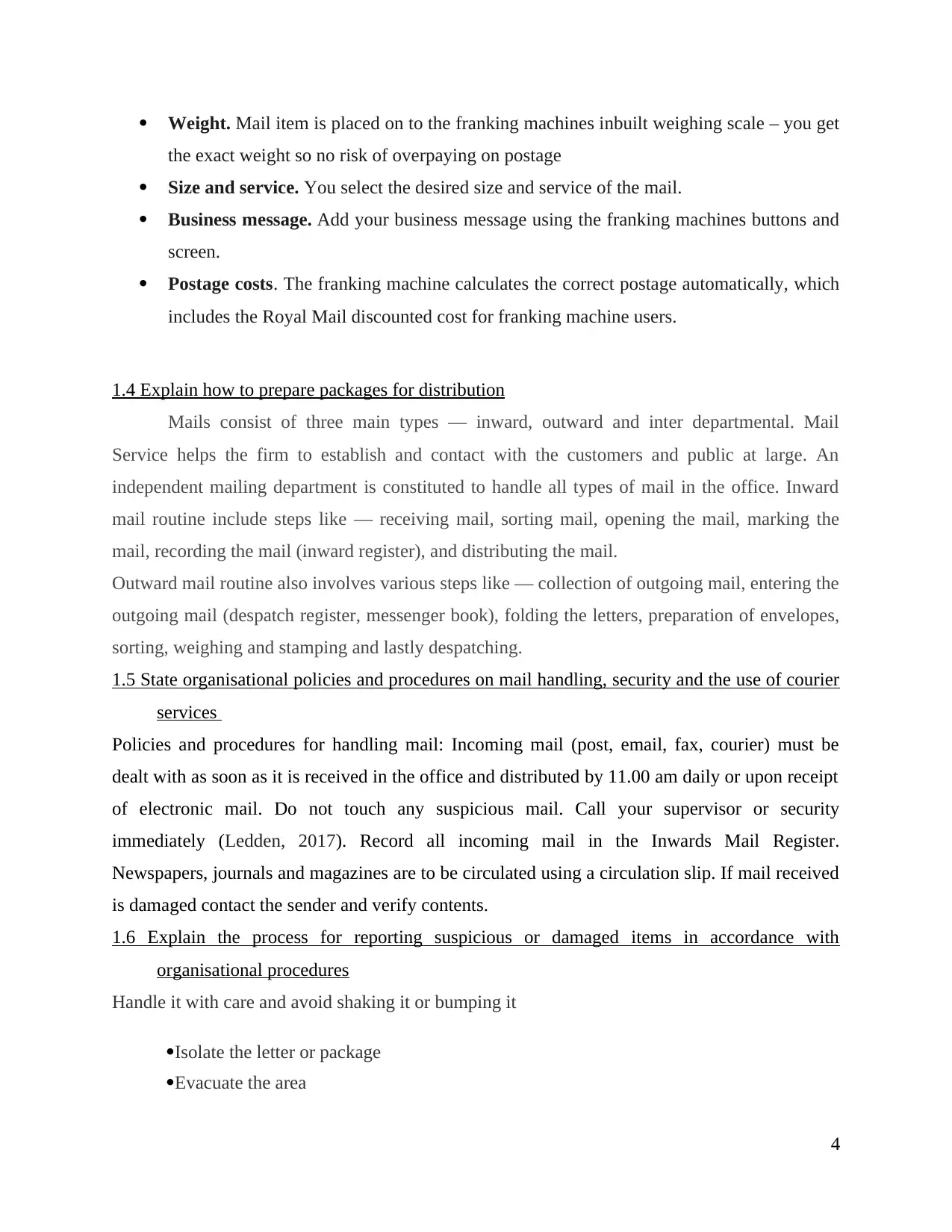
Weight. Mail item is placed on to the franking machines inbuilt weighing scale – you get
the exact weight so no risk of overpaying on postage
Size and service. You select the desired size and service of the mail.
Business message. Add your business message using the franking machines buttons and
screen.
Postage costs. The franking machine calculates the correct postage automatically, which
includes the Royal Mail discounted cost for franking machine users.
1.4 Explain how to prepare packages for distribution
Mails consist of three main types — inward, outward and inter departmental. Mail
Service helps the firm to establish and contact with the customers and public at large. An
independent mailing department is constituted to handle all types of mail in the office. Inward
mail routine include steps like — receiving mail, sorting mail, opening the mail, marking the
mail, recording the mail (inward register), and distributing the mail.
Outward mail routine also involves various steps like — collection of outgoing mail, entering the
outgoing mail (despatch register, messenger book), folding the letters, preparation of envelopes,
sorting, weighing and stamping and lastly despatching.
1.5 State organisational policies and procedures on mail handling, security and the use of courier
services
Policies and procedures for handling mail: Incoming mail (post, email, fax, courier) must be
dealt with as soon as it is received in the office and distributed by 11.00 am daily or upon receipt
of electronic mail. Do not touch any suspicious mail. Call your supervisor or security
immediately (Ledden, 2017). Record all incoming mail in the Inwards Mail Register.
Newspapers, journals and magazines are to be circulated using a circulation slip. If mail received
is damaged contact the sender and verify contents.
1.6 Explain the process for reporting suspicious or damaged items in accordance with
organisational procedures
Handle it with care and avoid shaking it or bumping it
Isolate the letter or package
Evacuate the area
4
the exact weight so no risk of overpaying on postage
Size and service. You select the desired size and service of the mail.
Business message. Add your business message using the franking machines buttons and
screen.
Postage costs. The franking machine calculates the correct postage automatically, which
includes the Royal Mail discounted cost for franking machine users.
1.4 Explain how to prepare packages for distribution
Mails consist of three main types — inward, outward and inter departmental. Mail
Service helps the firm to establish and contact with the customers and public at large. An
independent mailing department is constituted to handle all types of mail in the office. Inward
mail routine include steps like — receiving mail, sorting mail, opening the mail, marking the
mail, recording the mail (inward register), and distributing the mail.
Outward mail routine also involves various steps like — collection of outgoing mail, entering the
outgoing mail (despatch register, messenger book), folding the letters, preparation of envelopes,
sorting, weighing and stamping and lastly despatching.
1.5 State organisational policies and procedures on mail handling, security and the use of courier
services
Policies and procedures for handling mail: Incoming mail (post, email, fax, courier) must be
dealt with as soon as it is received in the office and distributed by 11.00 am daily or upon receipt
of electronic mail. Do not touch any suspicious mail. Call your supervisor or security
immediately (Ledden, 2017). Record all incoming mail in the Inwards Mail Register.
Newspapers, journals and magazines are to be circulated using a circulation slip. If mail received
is damaged contact the sender and verify contents.
1.6 Explain the process for reporting suspicious or damaged items in accordance with
organisational procedures
Handle it with care and avoid shaking it or bumping it
Isolate the letter or package
Evacuate the area
4
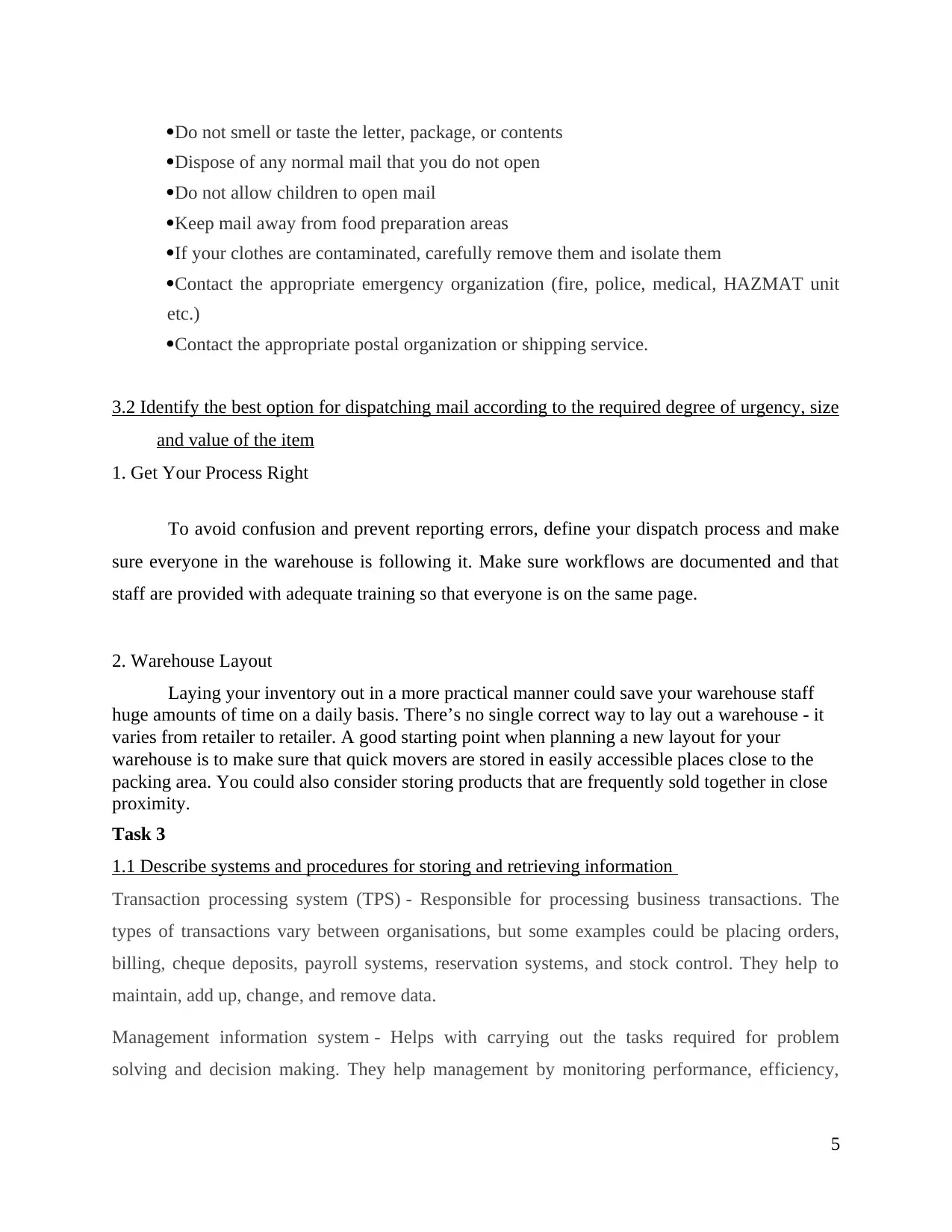
Do not smell or taste the letter, package, or contents
Dispose of any normal mail that you do not open
Do not allow children to open mail
Keep mail away from food preparation areas
If your clothes are contaminated, carefully remove them and isolate them
Contact the appropriate emergency organization (fire, police, medical, HAZMAT unit
etc.)
Contact the appropriate postal organization or shipping service.
3.2 Identify the best option for dispatching mail according to the required degree of urgency, size
and value of the item
1. Get Your Process Right
To avoid confusion and prevent reporting errors, define your dispatch process and make
sure everyone in the warehouse is following it. Make sure workflows are documented and that
staff are provided with adequate training so that everyone is on the same page.
2. Warehouse Layout
Laying your inventory out in a more practical manner could save your warehouse staff
huge amounts of time on a daily basis. There’s no single correct way to lay out a warehouse - it
varies from retailer to retailer. A good starting point when planning a new layout for your
warehouse is to make sure that quick movers are stored in easily accessible places close to the
packing area. You could also consider storing products that are frequently sold together in close
proximity.
Task 3
1.1 Describe systems and procedures for storing and retrieving information
Transaction processing system (TPS) - Responsible for processing business transactions. The
types of transactions vary between organisations, but some examples could be placing orders,
billing, cheque deposits, payroll systems, reservation systems, and stock control. They help to
maintain, add up, change, and remove data.
Management information system - Helps with carrying out the tasks required for problem
solving and decision making. They help management by monitoring performance, efficiency,
5
Dispose of any normal mail that you do not open
Do not allow children to open mail
Keep mail away from food preparation areas
If your clothes are contaminated, carefully remove them and isolate them
Contact the appropriate emergency organization (fire, police, medical, HAZMAT unit
etc.)
Contact the appropriate postal organization or shipping service.
3.2 Identify the best option for dispatching mail according to the required degree of urgency, size
and value of the item
1. Get Your Process Right
To avoid confusion and prevent reporting errors, define your dispatch process and make
sure everyone in the warehouse is following it. Make sure workflows are documented and that
staff are provided with adequate training so that everyone is on the same page.
2. Warehouse Layout
Laying your inventory out in a more practical manner could save your warehouse staff
huge amounts of time on a daily basis. There’s no single correct way to lay out a warehouse - it
varies from retailer to retailer. A good starting point when planning a new layout for your
warehouse is to make sure that quick movers are stored in easily accessible places close to the
packing area. You could also consider storing products that are frequently sold together in close
proximity.
Task 3
1.1 Describe systems and procedures for storing and retrieving information
Transaction processing system (TPS) - Responsible for processing business transactions. The
types of transactions vary between organisations, but some examples could be placing orders,
billing, cheque deposits, payroll systems, reservation systems, and stock control. They help to
maintain, add up, change, and remove data.
Management information system - Helps with carrying out the tasks required for problem
solving and decision making. They help management by monitoring performance, efficiency,
5
⊘ This is a preview!⊘
Do you want full access?
Subscribe today to unlock all pages.

Trusted by 1+ million students worldwide
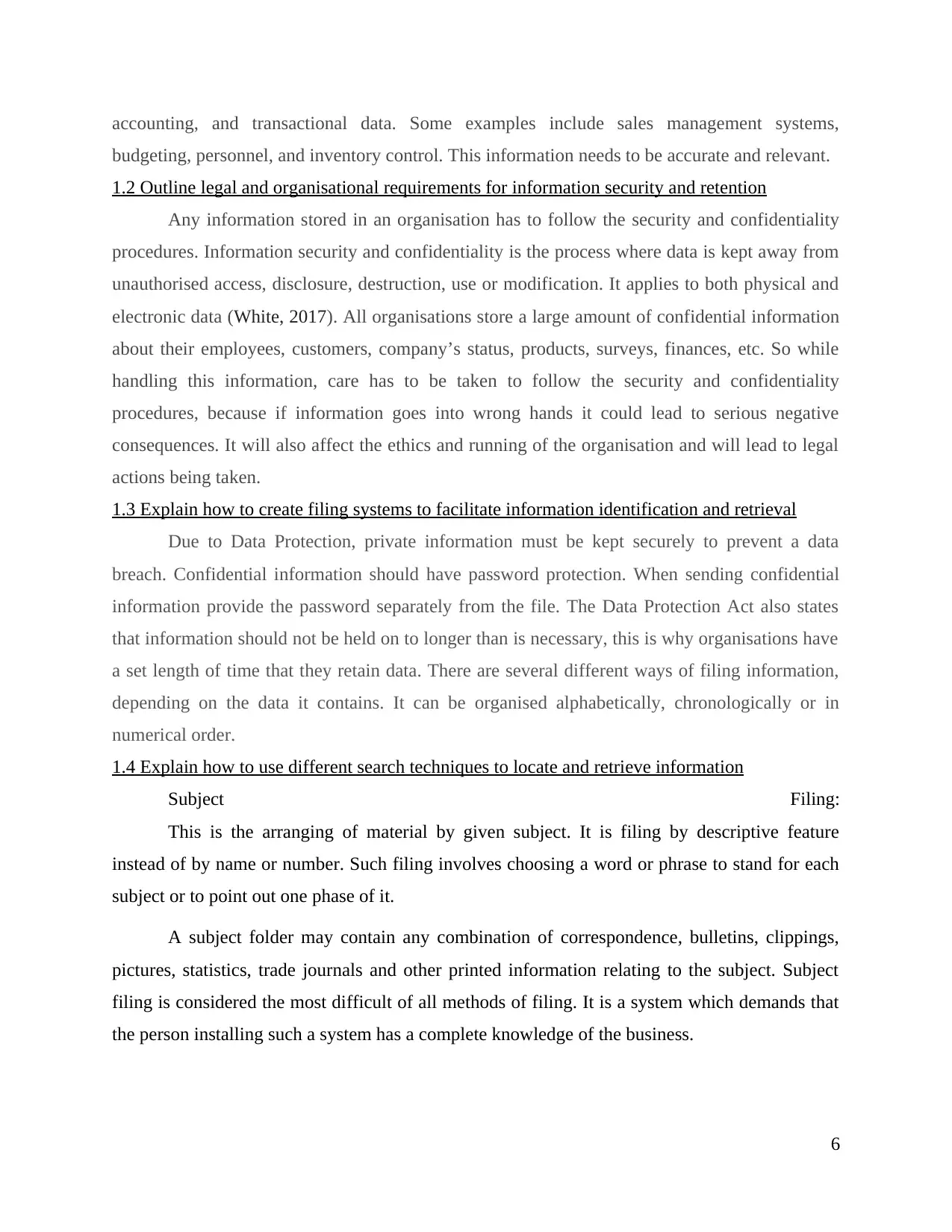
accounting, and transactional data. Some examples include sales management systems,
budgeting, personnel, and inventory control. This information needs to be accurate and relevant.
1.2 Outline legal and organisational requirements for information security and retention
Any information stored in an organisation has to follow the security and confidentiality
procedures. Information security and confidentiality is the process where data is kept away from
unauthorised access, disclosure, destruction, use or modification. It applies to both physical and
electronic data (White, 2017). All organisations store a large amount of confidential information
about their employees, customers, company’s status, products, surveys, finances, etc. So while
handling this information, care has to be taken to follow the security and confidentiality
procedures, because if information goes into wrong hands it could lead to serious negative
consequences. It will also affect the ethics and running of the organisation and will lead to legal
actions being taken.
1.3 Explain how to create filing systems to facilitate information identification and retrieval
Due to Data Protection, private information must be kept securely to prevent a data
breach. Confidential information should have password protection. When sending confidential
information provide the password separately from the file. The Data Protection Act also states
that information should not be held on to longer than is necessary, this is why organisations have
a set length of time that they retain data. There are several different ways of filing information,
depending on the data it contains. It can be organised alphabetically, chronologically or in
numerical order.
1.4 Explain how to use different search techniques to locate and retrieve information
Subject Filing:
This is the arranging of material by given subject. It is filing by descriptive feature
instead of by name or number. Such filing involves choosing a word or phrase to stand for each
subject or to point out one phase of it.
A subject folder may contain any combination of correspondence, bulletins, clippings,
pictures, statistics, trade journals and other printed information relating to the subject. Subject
filing is considered the most difficult of all methods of filing. It is a system which demands that
the person installing such a system has a complete knowledge of the business.
6
budgeting, personnel, and inventory control. This information needs to be accurate and relevant.
1.2 Outline legal and organisational requirements for information security and retention
Any information stored in an organisation has to follow the security and confidentiality
procedures. Information security and confidentiality is the process where data is kept away from
unauthorised access, disclosure, destruction, use or modification. It applies to both physical and
electronic data (White, 2017). All organisations store a large amount of confidential information
about their employees, customers, company’s status, products, surveys, finances, etc. So while
handling this information, care has to be taken to follow the security and confidentiality
procedures, because if information goes into wrong hands it could lead to serious negative
consequences. It will also affect the ethics and running of the organisation and will lead to legal
actions being taken.
1.3 Explain how to create filing systems to facilitate information identification and retrieval
Due to Data Protection, private information must be kept securely to prevent a data
breach. Confidential information should have password protection. When sending confidential
information provide the password separately from the file. The Data Protection Act also states
that information should not be held on to longer than is necessary, this is why organisations have
a set length of time that they retain data. There are several different ways of filing information,
depending on the data it contains. It can be organised alphabetically, chronologically or in
numerical order.
1.4 Explain how to use different search techniques to locate and retrieve information
Subject Filing:
This is the arranging of material by given subject. It is filing by descriptive feature
instead of by name or number. Such filing involves choosing a word or phrase to stand for each
subject or to point out one phase of it.
A subject folder may contain any combination of correspondence, bulletins, clippings,
pictures, statistics, trade journals and other printed information relating to the subject. Subject
filing is considered the most difficult of all methods of filing. It is a system which demands that
the person installing such a system has a complete knowledge of the business.
6
Paraphrase This Document
Need a fresh take? Get an instant paraphrase of this document with our AI Paraphraser
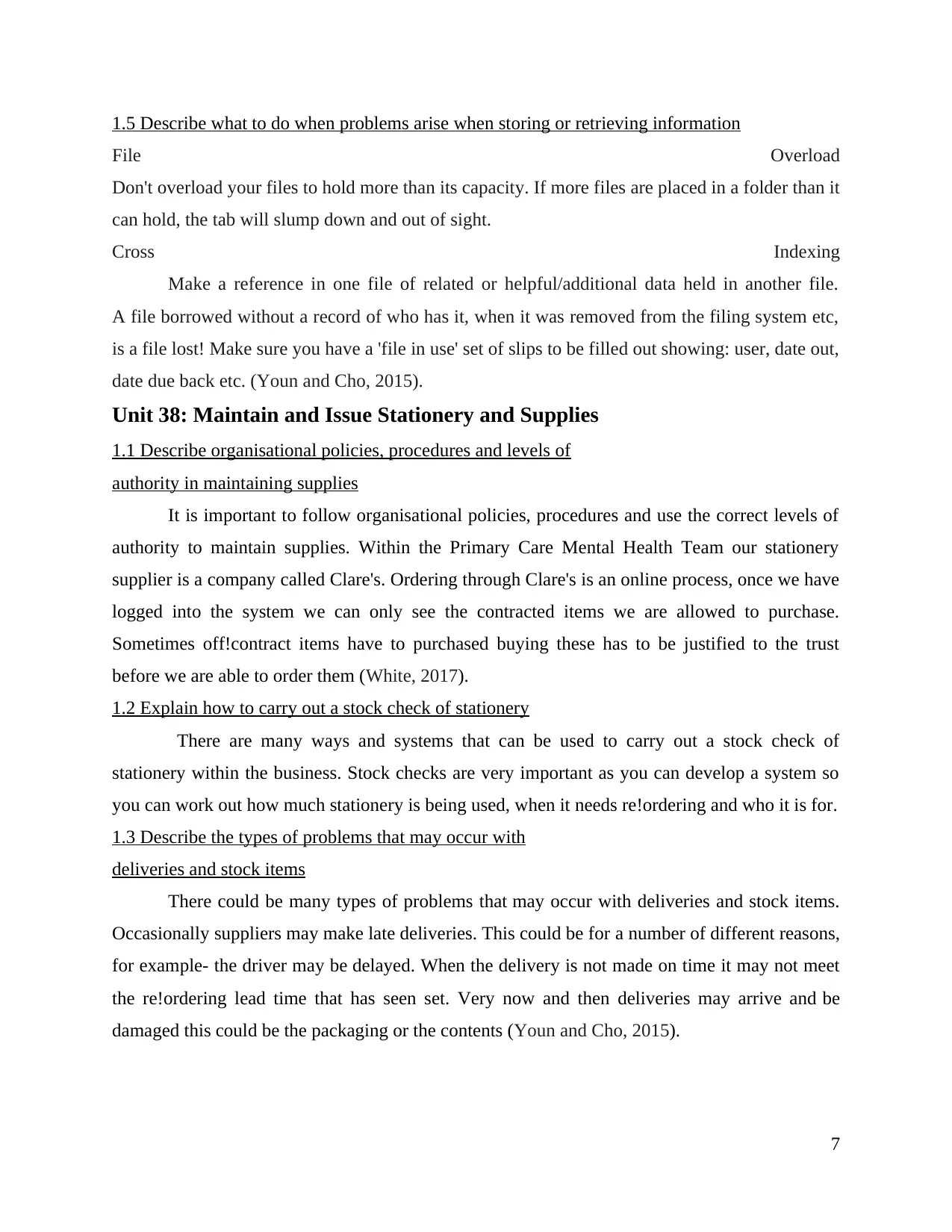
1.5 Describe what to do when problems arise when storing or retrieving information
File Overload
Don't overload your files to hold more than its capacity. If more files are placed in a folder than it
can hold, the tab will slump down and out of sight.
Cross Indexing
Make a reference in one file of related or helpful/additional data held in another file.
A file borrowed without a record of who has it, when it was removed from the filing system etc,
is a file lost! Make sure you have a 'file in use' set of slips to be filled out showing: user, date out,
date due back etc. (Youn and Cho, 2015).
Unit 38: Maintain and Issue Stationery and Supplies
1.1 Describe organisational policies, procedures and levels of
authority in maintaining supplies
It is important to follow organisational policies, procedures and use the correct levels of
authority to maintain supplies. Within the Primary Care Mental Health Team our stationery
supplier is a company called Clare's. Ordering through Clare's is an online process, once we have
logged into the system we can only see the contracted items we are allowed to purchase.
Sometimes off!contract items have to purchased buying these has to be justified to the trust
before we are able to order them (White, 2017).
1.2 Explain how to carry out a stock check of stationery
There are many ways and systems that can be used to carry out a stock check of
stationery within the business. Stock checks are very important as you can develop a system so
you can work out how much stationery is being used, when it needs re!ordering and who it is for.
1.3 Describe the types of problems that may occur with
deliveries and stock items
There could be many types of problems that may occur with deliveries and stock items.
Occasionally suppliers may make late deliveries. This could be for a number of different reasons,
for example- the driver may be delayed. When the delivery is not made on time it may not meet
the re!ordering lead time that has seen set. Very now and then deliveries may arrive and be
damaged this could be the packaging or the contents (Youn and Cho, 2015).
7
File Overload
Don't overload your files to hold more than its capacity. If more files are placed in a folder than it
can hold, the tab will slump down and out of sight.
Cross Indexing
Make a reference in one file of related or helpful/additional data held in another file.
A file borrowed without a record of who has it, when it was removed from the filing system etc,
is a file lost! Make sure you have a 'file in use' set of slips to be filled out showing: user, date out,
date due back etc. (Youn and Cho, 2015).
Unit 38: Maintain and Issue Stationery and Supplies
1.1 Describe organisational policies, procedures and levels of
authority in maintaining supplies
It is important to follow organisational policies, procedures and use the correct levels of
authority to maintain supplies. Within the Primary Care Mental Health Team our stationery
supplier is a company called Clare's. Ordering through Clare's is an online process, once we have
logged into the system we can only see the contracted items we are allowed to purchase.
Sometimes off!contract items have to purchased buying these has to be justified to the trust
before we are able to order them (White, 2017).
1.2 Explain how to carry out a stock check of stationery
There are many ways and systems that can be used to carry out a stock check of
stationery within the business. Stock checks are very important as you can develop a system so
you can work out how much stationery is being used, when it needs re!ordering and who it is for.
1.3 Describe the types of problems that may occur with
deliveries and stock items
There could be many types of problems that may occur with deliveries and stock items.
Occasionally suppliers may make late deliveries. This could be for a number of different reasons,
for example- the driver may be delayed. When the delivery is not made on time it may not meet
the re!ordering lead time that has seen set. Very now and then deliveries may arrive and be
damaged this could be the packaging or the contents (Youn and Cho, 2015).
7
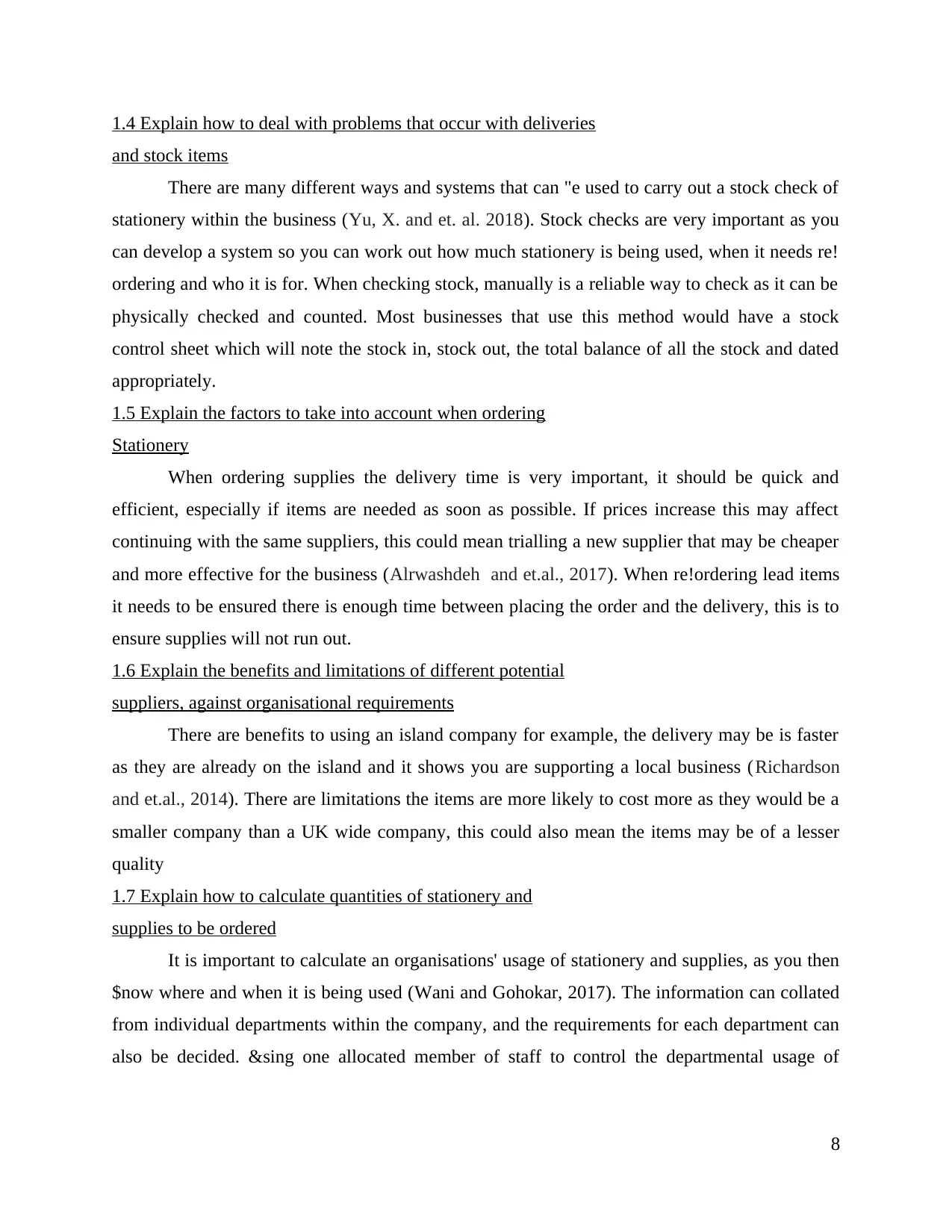
1.4 Explain how to deal with problems that occur with deliveries
and stock items
There are many different ways and systems that can "e used to carry out a stock check of
stationery within the business (Yu, X. and et. al. 2018). Stock checks are very important as you
can develop a system so you can work out how much stationery is being used, when it needs re!
ordering and who it is for. When checking stock, manually is a reliable way to check as it can be
physically checked and counted. Most businesses that use this method would have a stock
control sheet which will note the stock in, stock out, the total balance of all the stock and dated
appropriately.
1.5 Explain the factors to take into account when ordering
Stationery
When ordering supplies the delivery time is very important, it should be quick and
efficient, especially if items are needed as soon as possible. If prices increase this may affect
continuing with the same suppliers, this could mean trialling a new supplier that may be cheaper
and more effective for the business (Alrwashdeh and et.al., 2017). When re!ordering lead items
it needs to be ensured there is enough time between placing the order and the delivery, this is to
ensure supplies will not run out.
1.6 Explain the benefits and limitations of different potential
suppliers, against organisational requirements
There are benefits to using an island company for example, the delivery may be is faster
as they are already on the island and it shows you are supporting a local business (Richardson
and et.al., 2014). There are limitations the items are more likely to cost more as they would be a
smaller company than a UK wide company, this could also mean the items may be of a lesser
quality
1.7 Explain how to calculate quantities of stationery and
supplies to be ordered
It is important to calculate an organisations' usage of stationery and supplies, as you then
$now where and when it is being used (Wani and Gohokar, 2017). The information can collated
from individual departments within the company, and the requirements for each department can
also be decided. &sing one allocated member of staff to control the departmental usage of
8
and stock items
There are many different ways and systems that can "e used to carry out a stock check of
stationery within the business (Yu, X. and et. al. 2018). Stock checks are very important as you
can develop a system so you can work out how much stationery is being used, when it needs re!
ordering and who it is for. When checking stock, manually is a reliable way to check as it can be
physically checked and counted. Most businesses that use this method would have a stock
control sheet which will note the stock in, stock out, the total balance of all the stock and dated
appropriately.
1.5 Explain the factors to take into account when ordering
Stationery
When ordering supplies the delivery time is very important, it should be quick and
efficient, especially if items are needed as soon as possible. If prices increase this may affect
continuing with the same suppliers, this could mean trialling a new supplier that may be cheaper
and more effective for the business (Alrwashdeh and et.al., 2017). When re!ordering lead items
it needs to be ensured there is enough time between placing the order and the delivery, this is to
ensure supplies will not run out.
1.6 Explain the benefits and limitations of different potential
suppliers, against organisational requirements
There are benefits to using an island company for example, the delivery may be is faster
as they are already on the island and it shows you are supporting a local business (Richardson
and et.al., 2014). There are limitations the items are more likely to cost more as they would be a
smaller company than a UK wide company, this could also mean the items may be of a lesser
quality
1.7 Explain how to calculate quantities of stationery and
supplies to be ordered
It is important to calculate an organisations' usage of stationery and supplies, as you then
$now where and when it is being used (Wani and Gohokar, 2017). The information can collated
from individual departments within the company, and the requirements for each department can
also be decided. &sing one allocated member of staff to control the departmental usage of
8
⊘ This is a preview!⊘
Do you want full access?
Subscribe today to unlock all pages.

Trusted by 1+ million students worldwide
1 out of 18
Related Documents
Your All-in-One AI-Powered Toolkit for Academic Success.
+13062052269
info@desklib.com
Available 24*7 on WhatsApp / Email
![[object Object]](/_next/static/media/star-bottom.7253800d.svg)
Unlock your academic potential
Copyright © 2020–2025 A2Z Services. All Rights Reserved. Developed and managed by ZUCOL.





